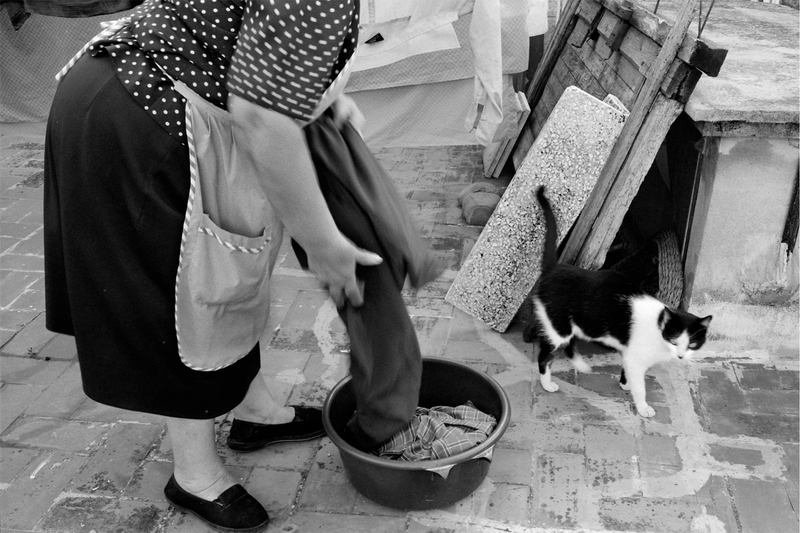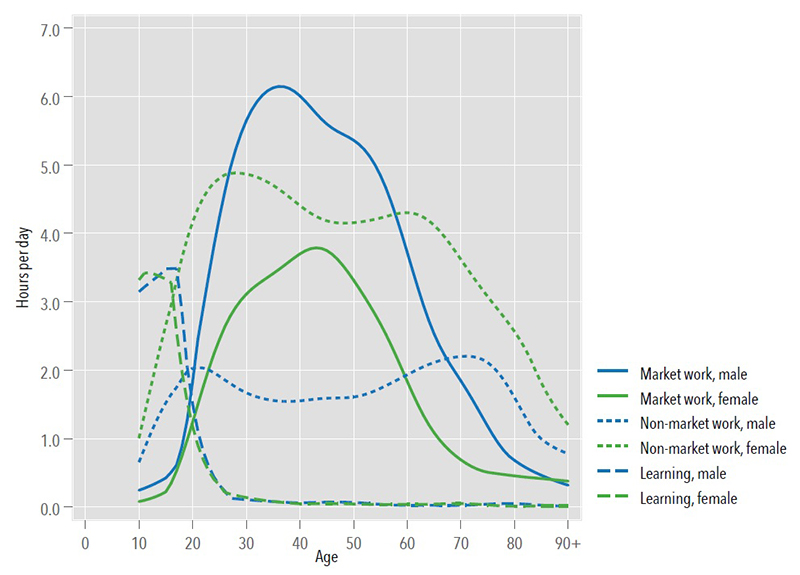Counting women’s work
07 October 2019 | Story Charmaine Smith. Photo Carolina Latorre Canet, Wikimedia. Read time >10 min.
Counting Women’s Work is an international project to measure the gendered economy, including unpaid care work. The project provides data and analysis to help develop better policies on economic development, care for children and the elderly, investments in human capital, and gender equity in the workplace and the home.
Valuing unpaid care work is important because care-giving sustains families, and ultimately, helps to preserve society. While it contributes considerably towards a country’s total welfare and economic output, the value of unpaid care has been difficult to determine because standard measures of the economy include care only if it is paid for.
Counting Women’s Work is part of the National Transfer Accounts project which stretches across 60 countries and uses standardised methods and tools to measure how people at different ages produce, consume and share resources, and save for the future.
The specific contribution of Counting Women’s Work is insight on how males and females across all ages produce, consume, transfer and save, and to estimate the time and monetary value of unpaid care within households. Unpaid care (non-market work) includes housework – such as cooking, cleaning, household management and maintenance – and direct care provided to children, elders and the community.
The results of the project will also inform the indicators of the United Nations Sustainable Development Goal relating to gender. Goal 5.4 requires that countries “[r]ecognize and value unpaid care and domestic work through the provision of public services, infrastructure and social protection policies and the promotion of shared responsibility within the household and the family as nationally appropriate”.
South African women carry the burden of unpaid care
The South African component of the research spans data analysis for 2000 and 2010.
Morné Oosthuizen, a researcher with the University of Cape Town (UCT) Development Policy Research Unit and the South Africa project coordinator for Counting Women’s Work, says the findings show that women still do the vast majority of unpaid care work.
“Almost three-quarters of this household production was contributed by females.”
“By drawing on the Time Use Survey 2010 data from Statistics South Africa and National Transfer Accounts data for 2010, household production is valued at ZAR749.9 billion in 2010.
“Almost three-quarters of this household production was contributed by females.”
Oosthuizen used a specialist replacement wage to calculate household production in monetary terms and found that such production was equivalent to 27.3% of GDP.
“To put this into context, labour income is estimated at 51.1% of GDP. Females contribute 73.8% of the value of household production, while 57% of the total was accounted for by women and men aged 18 to 39 years.”

Data analysis shows that women’s time doing housework rises rapidly during their teens and early 20s. It remains relatively stable from their late 20s to their early 60s, and then declines. There were two peaks in the amount of time females spent on housework: around 30 and 60 years old.
The ages when men spent the most time on housework occurred respectively sooner and later.
Women’s time allocations for care was highest during their 20s and 30s. The data analysis shows that males, though, spent little time in care activities at any age.
“Men’s peak time allocation to care is during their 70s. They account for less than one-fifth of all the time allocated to care and just 11.2% of care for household members.”
Women’s time allocations for care was highest during their 20s and 30s. The data analysis shows that males, though, spent little time in care activities at any age.
Looking at consumption patterns from birth until old age, the researchers found that infants’ per capita consumption tripled when household production was included alongside estimates of market production and consumption.
Oosthuizen points out that these results reveal the substantial “hidden costs” of young children. “Infants and children are therefore the highest consumers of unpaid household production. This is an important result given its implications for policies related to encouraging women’s greater economic participation.”
Women outproduce men
The results show that it’s between the ages of 20 and 60 years old that men and women allocate the maximum amount of their time to market work, which includes wage work in the formal or informal sectors, and work for household-owned businesses and farms.
On the other hand, the time men and women spent on housework did not vary as substantially by age.
“But looking at the estimates by gender shows that males spend more than three-fifths of their total productive time in market work. They also spend more time in market work at virtually every age.
“Females, on the other hand, spend 71% of their productive time on household production averaged across all ages.”
On the production side, the research shows that “males outproduced females at all ages in terms of labour income but, once non-market production is included, females outproduce males in per capita terms in all age groups up to ages 41 and after 72 years and older.”
In other words, females for most of their lives outproduce males in their per capita contribution to total production.
The reason why the burden of unpaid care work in South Africa is still largely carried by women is partly due to the high prevalence of labour migration, which separates men from their families for long periods. Traditional ideas of ‘women’s work’ also play a role. These come at a cost for girls seeking education and women looking for greater participation in paid labour.
Sharing unpaid work to boost economic growth
The South African analysis for Counting Women’s Work informed the project’s country report, while the local team shared the research with many policymakers in the country. The researchers have been an important part of spreading to other countries in Africa the project’s approach to understanding the role of age and gender in economies.
In other words, females for most of their lives outproduce males in their per capita contribution to total production.
“One way that we have been using the results to gain some traction on the issue of unpaid work is to illustrate how reducing gender inequalities can boost the demographic dividend – the potential boost to living standards and economic growth resulting from falling fertility – and how sharing the burden of unpaid work more equitably underpins this.”
The research team makes several policy recommendations based on their findings.
These include the need to acknowledge the importance of the everyday contributions of South Africa’s women to the nation’s well-being and total production, and to encourage a national conversation on norms around gender roles.
They also recommend policies to support market-provided childcare for adult women and perhaps also for younger women whose final school years might be interrupted by family care responsibilities. They have also put forward suggestions for policies that encourage men to take more active roles in their households, especially childcare, and greater work flexibility for all parents.
- Oosthuizen M (2018) Counting Women’s Work in South Africa. Incorporating Unpaid Work into Estimates of the Economic Lifecycle in 2010. Cape Town: Development Policy Research Unit, University of Cape Town. P. 12.
Counting Women’s Work is coordinated by the University of California, Berkeley; the UCT Development Policy Research Unit; and the East-West Center, Honolulu. The project has supported research in 10 low- and middle-income countries around the world: Bangladesh, Colombia, Costa Rica, Mexico, Ghana, Kenya, Senegal, South Africa, India and Vietnam.
Funding for the research was made available by the International Development Research Centre, Canada, and the William and Flora Hewlett Foundation.
Visit the Counting Women’s Work website for more details, research reports and other resources.
 This work is licensed under a Creative Commons Attribution-NoDerivatives 4.0 International License.
This work is licensed under a Creative Commons Attribution-NoDerivatives 4.0 International License.
Please view the republishing articles page for more information.










